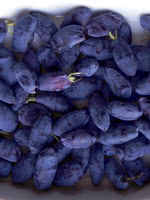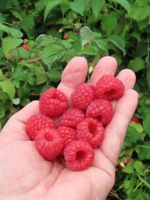Mon-Fri 9am - 5pm Mountain time
Honey Bee Haskap (Honeyberry) vs Red Mammoth Raspberry
Lonicera caerulea Honey Bee
Rubus sp. SK Red Mammoth
NOT AVAILABLE THIS SEASON - MIGHT RETURN
SOLD OUT
Honey Bee Haskap produces tarter fruit than the Aurora and Borealis varieties and is known for bearing fruit at a younger age. The flavour of Haskaps is generally described as a cross between a blueberry and a raspberry. Honey Bee Haskaps are well suited to fresh eating, freezing, baking, and preserves.
The Honey Bee Haskap has stronger fruit holds than other varieties so the berries stay on the bush longer. The berries do not roll well so they are not recommended for mechanical harvesting.
For optimal fruit production, cross-pollination is required. Haskaps need to be planted with a compatible variety. Compatibility is influenced by both bloom time and genetics.
Honey Bee Haskap is an early-pollinating variety and pairs well with Aurora, Borealis, Tundra, and Indigo Gem.
Developed by the University of Saskatchewan Fruit Program, SK. Red Mammoth was a high yielding and firm variety released in 1999. It produces distinctively large bright red berries about 1 inch wide. It is also more cold hardy than older raspberry cultivars. Red Mammoth is firm which makes it suitable for commercial production and sweeter than Boyne. Floricane.
Needs to be trellised as canes are not as sturdy as other varieties.

